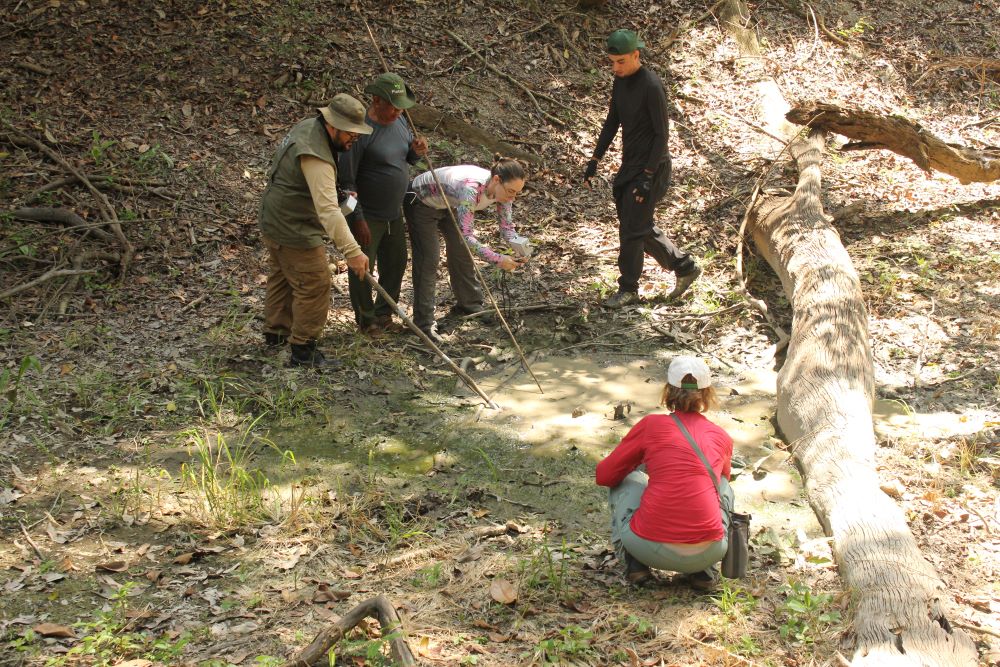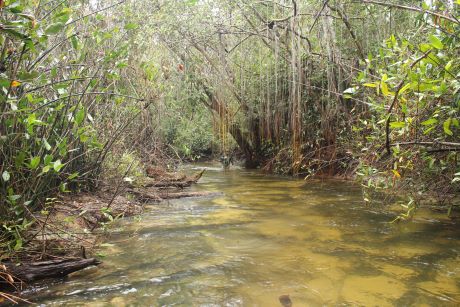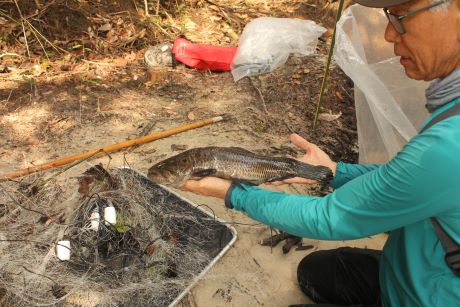

Team tries to catch poraquê living in an almost dry well on an island in the Jauaperi River, in Roraima state. The species is highly resilient and, because it breathes atmospheric air, can live even in waters with little oxygen (photo: André Julião/Agência FAPESP)
A species from the Negro River basin uses the spaces between the roots and hollows of trees to build nests and care for its young for four to six months, leaving only at night to hunt.
A species from the Negro River basin uses the spaces between the roots and hollows of trees to build nests and care for its young for four to six months, leaving only at night to hunt.

Team tries to catch poraquê living in an almost dry well on an island in the Jauaperi River, in Roraima state. The species is highly resilient and, because it breathes atmospheric air, can live even in waters with little oxygen (photo: André Julião/Agência FAPESP)
By André Julião*, from Santa Isabel do Rio Negro | Agência FAPESP – Being in an igarapé, a stream that rises in the forest and flows into the river, can be like visiting a condominium when it comes to the Negro River basin. In this case, some of the residents are poraquês of the species Electrophorus varii, which emit electrical pulses of up to 650 volts.
This was the situation encountered by the DEGy Negro River Expedition during its passage along the Preto River, in the municipality of Santa Isabel do Rio Negro (Amazonas state, Brazil). During a journey of around 3 kilometers along a stream on the opposite bank to the community of Campina do Rio Preto, the researchers detected electrical signals from the poraquês, but did not see or catch any specimens.
“In the vegetation typical of the banks of igarapés, the igapó, the bases of the trunks often become hollow. Some form domes in which the poraquês can take shelter and climb up to breathe without leaving their burrow [these fish breathe by taking in atmospheric air through a respiratory organ in their mouths]. These are ideal places to lay eggs, fertilize them and take care of the young,” explains Carlos David de Santana, a research associate at the Smithsonian Institution’s National Museum of Natural History in the United States.

Stream where poraquês live in “condominiums” on the Preto River. In the background, researcher Raimundo Nonato Mendes Júnior (photo: André Julião/Agência FAPESP)
In addition to these hollows, the root-filled soil on the banks can be quite soft, allowing the poraquês to take advantage of the naturally formed tunnels that can go several meters into the banks of igarapés.
“When the water level rises and the young fish are independent, the poraquês will move through the entire flooded area of the igapó, making them much easier to see,” adds Santana.
This essential information about the life cycle of the species is known thanks to the work of Douglas Bastos, a researcher at the National Institute for Amazonian Research (INPA), and recorded for the first time in his doctoral thesis in the institution’s Postgraduate Program in Freshwater Biology and Fishing, published in 2020.
“We saw the same behavior in the Adolpho Ducke Reserve in Manaus [capital of the state of Amazonas], and it seems to be the species’ pattern,” says Bastos.
Agência FAPESP followed the expedition led by the Museum of Zoology of the University of São Paulo (MZ-USP) from its departure in São Paulo, up the Negro River from Manaus to Santa Isabel do Rio Negro, to the landing in Manaus and the return to São Paulo. The reports make up the Field Diary – Negro River series.
The DEGy Negro River Expedition was part of the “Diversity and Evolution of Gymnotiformes (DEGy)” project, supported by FAPESP.

André Julião, of Agência FAPESP, and Raimundo Nonato Mendes Júnior, of ICMBio and MZ-USP, push a boat up an igarapé on the Preto River (photo: Laura Donin/MZ-USP)
Housing development
In February, when the expedition took place, it was expected that the rivers and igarapés would be fuller. However, the historic drought in the Amazon region is still reflected in the abundance of fish in the Negro River basin.
Those that survived probably migrated to the headwaters, and the recovery time of the rivers’ bottom fauna is still unknown, according to the expedition’s researchers (read more at: agencia.fapesp.br/51873).
For the poraquês, however, the situation is not so bad. It is during the dry season that they mature sexually and settle in the shelters formed in the igarapés to reproduce and take care of their young. The little poraquês can be accompanied by their parents until they are six months old, during the transition to the rainy season, when they reach a length of about 15 centimeters.
At this stage, the parents teach the young fish how to hunt. Once they become independent, they live alone for the rest of the year until they reach sexual maturity, when they begin to search for their mates to form pairs during the next drought.
“It’s a very different behavior from the poraquês of the Xingu basin (Electrophorus voltai), which in the dry season congregate in lakes or at the mouths of igarapés, sheltering only from solar radiation, and hunt together in the early morning and early evening,” Santana recalls of another species of poraquê that emits discharges of up to 860 volts (read more at: onlinelibrary.wiley.com/doi/full/10.1002/ece3.7121).
For two days, Santana and MZ-USP doctoral students Laura Donin and Raimundo Nonato Gomes Mendes Júnior, who is also an environmental analyst at the Chico Mendes Institute for Biodiversity Conservation (ICMBio), traveled along the Preto River igarapé in search of the poraquês.
The device that detects the signals of the electric fish beeped every 100 to 200 meters, indicating the presence of the animals in various gullies.
“It’s like a condominium or a housing development. The shelters are very close together,” said a surprised Mendes, a first-time visitor to the Negro River basin, who had never seen such a density of individuals.
At one of the sites, a stick inserted into the ground caused a change in the electrical pulses emitted by the individual being monitored by the researchers. “A shock!” marveled Mendes. The animal had been hit, but did not come out of its burrow. Due to the low electrical conductivity of the waters in the Negro River basin and the distance between the researchers and the poraquês, the shock did not reach the team.
“The poraquês would have to be quite close for us to feel the shock. In more conductive waters, like those of the Amazon River, we might have felt it slightly,” Santana explains.
The next day, the researchers returned to the site, this time with hooks, bait and two nets. Unsuccessful with the hooks placed at the exit of the burrows, they left the nets to spend the night at the site. The idea was that, when they went out to feed, the poraquês would get stuck in the meshes (read more at: agencia.fapesp.br/36946/).
When the researchers returned to the site for the third time, only traíras and catfishes were tangled in the nets. These are other fish that use the tunnels in the banks for shelter. The poraquês remained hidden.

Instead of poraquês in the nets, the team found fish of other groups that also use the burrows on the banks of igarapés, such as traíras (photo: André Julião/Agência FAPESP)
488 volts
At the end of the expedition, part of the team went to INPA’s Science Forest in Manaus to demonstrate how to capture a poraquê in the field.
A poraquê of the species common to the Negro River basin (Electrophorus varii) is kept in captivity at the site. After surrounding the animal with nets in a shallower part of the tank, two electrodes (negative and positive) were placed in the water and connected to a device that amplifies the weak discharges used by the fish to communicate and locate themselves in the environment.

Poraquê of the species Electrophorus varii kept in captivity at INPA (photo: Phelipe Janning/Agência FAPESP)
“This allowed us to measure some properties of the electric wave, such as shape, frequency and amplitude, which are important characteristics for understanding how bioelectricity evolved among these animals,” explains Mendes.
This type of discharge is characteristic of all species of electric fish, both poraquês and sarapós. Each species emits electrical waves with a specific shape, amplitude and frequency.
The medium and strong discharges, on the other hand, are exclusive to poraquês and are emitted by different electrical organs. To measure them, the animal must be out of the water, on a plastic sheet that isolates it from the ground.
A negative electrode is placed on the tail and a positive electrode on the head, both of which are connected to a digital oscilloscope, a device that measures, among other things, the electrical tension in volts, popularly known as “voltage.” The specimen at INPA emitted a powerful discharge of 488 volts, but this species can emit up to 650 volts. It uses the shock to paralyze and devour its prey, as well as to scare away potential predators.
“In general, poraquês are very resilient animals, surviving the most inhospitable environments. The evolution of their anatomy, especially their electrical organs and their discharges, has certainly helped them get this far. It’s a big puzzle that we’re helping to piece together,” says Mendes.
Check out all the episodes of the Field Diary – Negro River series at: agencia.fapesp.br/en/field-diary.
* Phelipe Janning collaborated.
Republish
The Agency FAPESP licenses news via Creative Commons (CC-BY-NC-ND) so that they can be republished free of charge and in a simple way by other digital or printed vehicles. Agência FAPESP must be credited as the source of the content being republished and the name of the reporter (if any) must be attributed. Using the HMTL button below allows compliance with these rules, detailed in Digital Republishing Policy FAPESP.





